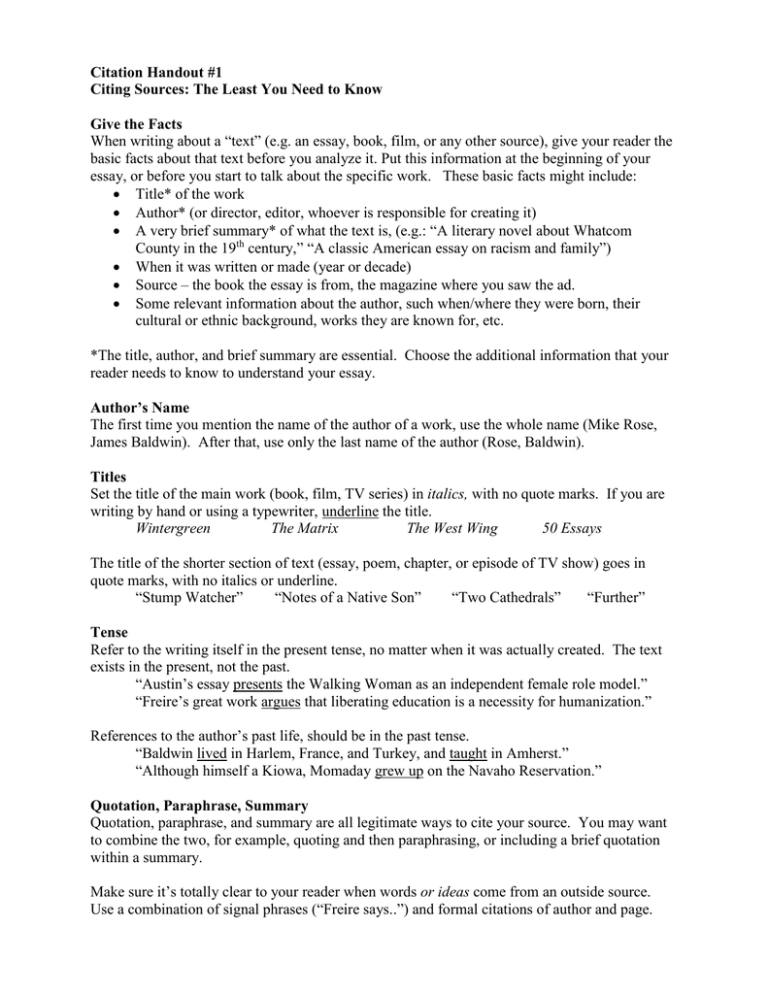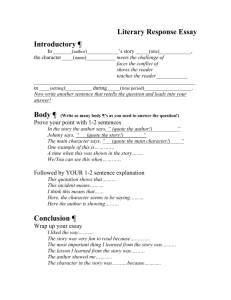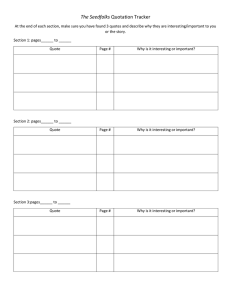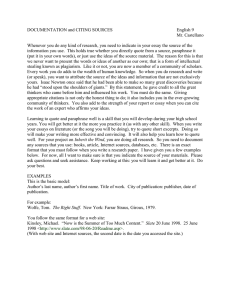Citation Handout #1 Citing Sources: The Least You Need to Know
advertisement

Citation Handout #1 Citing Sources: The Least You Need to Know Give the Facts When writing about a “text” (e.g. an essay, book, film, or any other source), give your reader the basic facts about that text before you analyze it. Put this information at the beginning of your essay, or before you start to talk about the specific work. These basic facts might include: Title* of the work Author* (or director, editor, whoever is responsible for creating it) A very brief summary* of what the text is, (e.g.: “A literary novel about Whatcom County in the 19th century,” “A classic American essay on racism and family”) When it was written or made (year or decade) Source – the book the essay is from, the magazine where you saw the ad. Some relevant information about the author, such when/where they were born, their cultural or ethnic background, works they are known for, etc. *The title, author, and brief summary are essential. Choose the additional information that your reader needs to know to understand your essay. Author’s Name The first time you mention the name of the author of a work, use the whole name (Mike Rose, James Baldwin). After that, use only the last name of the author (Rose, Baldwin). Titles Set the title of the main work (book, film, TV series) in italics, with no quote marks. If you are writing by hand or using a typewriter, underline the title. Wintergreen The Matrix The West Wing 50 Essays The title of the shorter section of text (essay, poem, chapter, or episode of TV show) goes in quote marks, with no italics or underline. “Stump Watcher” “Notes of a Native Son” “Two Cathedrals” “Further” Tense Refer to the writing itself in the present tense, no matter when it was actually created. The text exists in the present, not the past. “Austin’s essay presents the Walking Woman as an independent female role model.” “Freire’s great work argues that liberating education is a necessity for humanization.” References to the author’s past life, should be in the past tense. “Baldwin lived in Harlem, France, and Turkey, and taught in Amherst.” “Although himself a Kiowa, Momaday grew up on the Navaho Reservation.” Quotation, Paraphrase, Summary Quotation, paraphrase, and summary are all legitimate ways to cite your source. You may want to combine the two, for example, quoting and then paraphrasing, or including a brief quotation within a summary. Make sure it’s totally clear to your reader when words or ideas come from an outside source. Use a combination of signal phrases (“Freire says..”) and formal citations of author and page. Quote when you want to examine the way an author says something, or point your reader to the detail, nuance, and subtlety of the author’s original writing. Quotation keeps the focus on the author’s exact words. Avoid quoting huge blocks of text – focus quotations on key lines and phrases that matter most to your argument. Paraphrase to focus on the central idea of a passage or paragraph, when you’re more concerned with what it means than how it is said. Paraphrase allows you to focus on the aspects of a text that relate to your argument. When paraphrasing, make sure you stay true to the meaning of the original text – don’t distort or change the author’s idea. Summarize when you want to give your reader an overall sense of what the text is about, or remind them of an important idea or theme in the work. A summary is a broad statement about the work – it lacks detail, but allows you to cover a lot of ground quickly. Signal Phrases for Quotes Use signal phrases to let your reader know a quote is coming, and what it will add to the essay. Common words to signal a quote: argues, establishes, insists, shows, demonstrates, proves, suggests, implies, describes, depicts, outlines, details. As Botstein argues, “But the rules of high school turn out not to be the rules of life” (2). Correct Punctuation for Quotes Periods and commas go inside the quote marks, unless the citation comes just after the quote. Question marks and exclamation points go inside the quote marks only when they are part of the material quoted. Otherwise, they go outside the quote marks. Citation following the quote: He makes it clear that the oppressors cannot give freedom to the oppressed: “Freedom is acquired by conquest, not by gift” (Freire 47). Opening sentence with quote. Note the comma goes inside the quote marks. “Oppression is domesticating,” announces Freire, and indeed my own fourth-grade teacher treated us like farm animals (51). Your question, incorporating a quote – question mark outside the quotes. What does Freire mean when he refers to “subjectivism and psychologism” (51)? Use ellipses if you leave out some words. (An ellipse: ...) Botstein suggests, “Secondary education must be rethought...Young people should graduate at 16, not 18” (2). Use brackets if you change something or add something to the quotation. (Brackets: [ ] ) Botstein adds, “The national outpouring after the Littleton [Colorado, 1998] shootings has forced us to confront something we have suspected for a long time” (2). For more on MLA citations see the following sources: - http://dept.sccd.ctc.edu/cclib/Research_Tools/Citation_Style_Guides/north/mlacite.asp - http://www.mla.org/ - Troyka, Lynn and Hesse, Douglas. Quick Access Compact. 389-429 - Rosenwasser & Stephen, Writing Analytically, Fourth Edition, 323-347.



